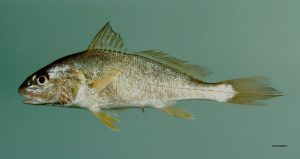Study Shows Oil Exposure Not Likely to Reduce Fish’s Ability to Compensate for Hypoxia
– SEPTEMBER 18, 2018
Researchers conducted experiments on Atlantic Croaker to determine if oil-induced respiratory impairment affects the fish’s tolerance to hypoxia. There were no observed effects from the combined stressors (oil exposure and hypoxia) on fish’s average critical oxygen threshold levels or its capacity to withstand hypoxia. These findings suggest that respiratory impairments associated with oil exposure may not have wide-scale detrimental outcomes for hypoxia tolerance in fish. However, the study points to possible sub-lethal effects from oil exposure on other traits that affect oxygen supply capacity, especially in hypoxia-tolerant fish, which may alter evolutionary trajectories following environmental stress. The researchers published their findings in Chemosphere: The effects of oil induced respiratory impairment on two indices of hypoxia tolerance in Atlantic croaker (Micropogonias undulatus).
The Deepwater Horizon incident coincided with the spawning season of many commercially important fish and with the natural occurrence of hypoxic or oxygen-minimum zones. Oil exposure in early life stage fish is known to impact oxygen uptake through cardiac impairment (Xu et al., 2016 and Khursigara et al., 2017), which raises questions about the additive effects of these two stressors.
Researchers conducted oil exposure and reduced-oxygen experiments on Atlantic croaker, a model organism for exploring hypoxia effects on Gulf of Mexico fish, using two indices of hypoxia tolerance: critical oxygen threshold (where an animal can no longer maintain standard metabolic rate through aerobic metabolism) and time to loss of equilibrium (indicator of aerobic and anaerobic capacity of the organism to withstand hypoxia).
The oil exposure treatments used high-energy water-accommodated fractions (HEWAFs) of non-weathered crude oil sufficient to impair oxygen supply capacity. The concentrations of 10.1 and 23.2 µgL-1 were well within the average sub-surface values (47 ± 28 µgL-1 SPAH; Sammarco et al., 2013) collected from coastal field sites in the northern Gulf of Mexico. The team calculated the oil’s effects on aerobic scope, time-to-loss of equilibrium, and critical oxygen threshold.
The maximum metabolic rate was the driver behind observed reductions in aerobic scope due to oil exposure, as there were no observed changes in standard metabolic rate. Individual critical oxygen thresholds revealed that fish with high initial hypoxia tolerance had greater impairment than hypoxia-sensitive individuals following oil exposure, when compared to fish in low-dose oil or control treatments. Oil-induced reductions in maximum metabolic rate did not cause consistent increases in critical oxygen threshold or reduced time to loss of equilibrium, suggesting that oil’s detrimental impacts on aerobic scope and minimum metabolic rate were reduced in magnitude as the ambient oxygen level approached critical oxygen threshold levels.
The authors explained that the oil’s impairment of a population’s most hypoxia-tolerant fish could alter the selective pressure of hypoxia events, as these fish are forced to rely on anaerobic metabolism under less extreme hypoxic events. Previous research indicates that hypoxia can act synergistically with oil and exacerbate cellular stress responses. The team suggests that future studies explore the mechanisms that oil exposure may differentially affect hypoxia-tolerant individuals and the potential ecosystem effects of this phenomenon.
Data are publicly available through the Gulf of Mexico Research Initiative Information & Data Cooperative (GRIIDC) at doi:10.7266/N78G8J3Q.
The study’s authors are Yihang K. Pan, Alexis J. Khursigara, Jacob L. Johansen, and Andrew J. Esbaugh.
************
This research was made possible in part by a grant from the Gulf of Mexico Research Initiative (GoMRI) to the Relationship of Effects of Cardiac Outcomes in Fish for Validation of Ecological Risk (RECOVER) consortium.
The Gulf of Mexico Research Initiative (GoMRI) is a 10-year independent research program established to study the effect, and the potential associated impact, of hydrocarbon releases on the environment and public health, as well as to develop improved spill mitigation, oil detection, characterization and remediation technologies. An independent and academic 20-member Research Board makes the funding and research direction decisions to ensure the intellectual quality, effectiveness and academic independence of the GoMRI research. All research data, findings and publications will be made publicly available. The program was established through a $500 million financial commitment from BP. For more information, visit https://gulfresearchinitiative.org/.
© Copyright 2010-2018 Gulf of Mexico Research Initiative (GoMRI) – All Rights Reserved. Redistribution is encouraged with acknowledgement to the Gulf of Mexico Research Initiative (GoMRI). Please credit images and/or videos as done in each article. Questions? Contact web-content editor Nilde “Maggie” Dannreuther, Northern Gulf Institute, Mississippi State University (maggied@ngi.msstate.edu).






